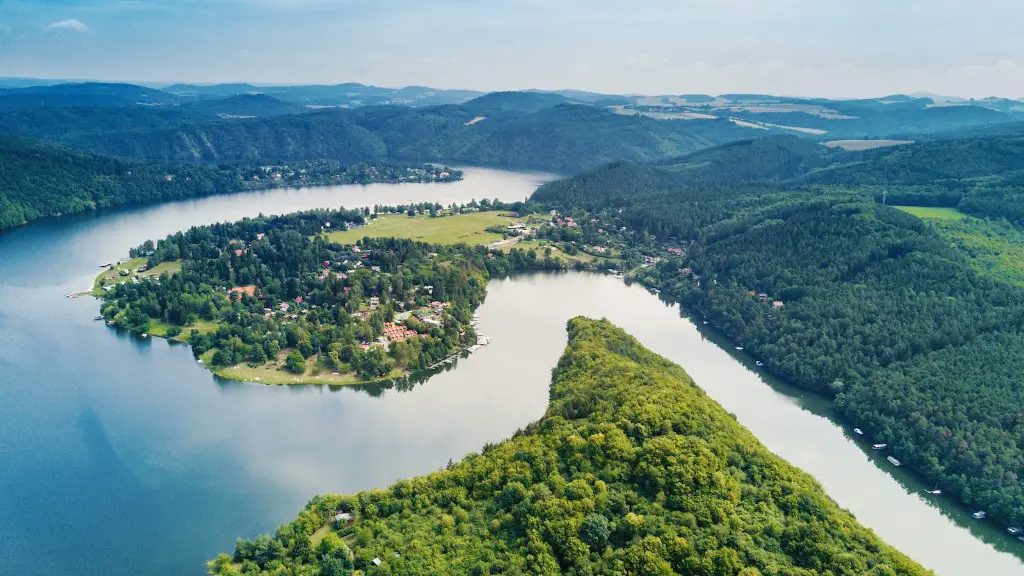The Yangtze River, located in China, is one of the world’s most impressive bodies of water. It is the longest river in Asia, with a total length of over 6,300 KM long, originating in the glaciers of the Tibetan Plateau and ending in the East China Sea near Shanghai. With its rich history, vibrant culture, and nearly 20 percent of China’s total population living near the river, the Yangtze River is filled with interesting facts.
One of the most interesting facts about the Yangtze River is its immense size. This great river throws off an average of 5,580 cubic meters of water every second and produces a tidal bore, or a surge of rushing tidal waves, which can measure up to 13 feet high! The river has seen floods as wide as 30 kilometers and can achieve depths of over 100 feet as it winds through fourteen provinces and two municipalities.
The region around the Yangtze River is home to some of the most fascinating flora and fauna in the world. There are a number of rare and endangered species located near the river, including the Yangtze finless porpoise and the Chinese alligator, a species that comes only in the lower and middle reaches of the Yangtze River.
The Yangtze is also home to some of China’s most stunning and unique geological formations, including the stunning Three Gorges – the Qutang, Wu and Xiling – carved over thousands of years by the river. In addition, the river contains many beautiful island and lake formations, such as the Fairy Mountains and Dongting Lake.
Another significant part of the Yangtze’s rich history is its impact on Chinese culture and religion. The Yangtze was a source of many important inventions and innovations in Chinese culture, such as the introduction of tea and papermaking, which originated along the banks of the river. The region has also been an important center for the practice of Confucianism and Taoism.
The river is also an important economic resource for many of the locals, providing much-needed employment, trade, and transportation. Fishing is a large industry along the Yangtze, with thousands of local fisherman providing for their families on the banks of the river.
Finally, the Yangtze River produces a plethora of power sources for the entire nation of China. There are a number of hydroelectric dams of varying sizes on the river, providing energy for tens of millions of people across the nation.
Environmental Impact
While the Yangtze has long been an integral part of Chinese culture and economy, the strength of the river has sometimes been a double-edged sword, leading to a number of environmental issues. The river has experienced numerous floods over the last century, which have tragically led to the loss of many human lives, as well as property and infrastructure damage.
In addition, the rapid industrial growth of the region has had a number of negative effects on the river, causing contamination of waters due to pollutants, as well as damaging river-side ecosystems and wildlife habitats. To combat these issues, the Chinese government has implemented a number of strategies, such as the “Great Cleanup” project.
The Great Cleanup project has seen the implementation of a number of measures to improve the health of the river, such as the installation of wastewater treatment plants and the creation of new national parks to protect wildlife. In addition, the Chinese government is also working to reduce pollution from ships and factories, as well as to monitor and control the water level of the Yangtze.
Economic Implications
The Yangtze River has been an important economic resource for China over the course of its history. The river is used for transportation, as many cities and towns are located along its banks, thus providing employment and trade opportunities for locals. In addition, the river has been a key source of electricity for the nation, with a number of hydroelectric dams providing power to millions of people.
In addition, fishing is a major industry on the Yangtze, with over 1.5 million fishermen providing for their families by catching a variety of species. Finally, tourism has become an increasingly important part of the economy near the Yangtze, with many people visiting the beautiful gorges, islands, and lakes that line the river.
Scientific Relevance
The Yangtze River has seen a large number of scientific studies and projects conducted in the region over the last century, many of which have significantly impacted both the local environment and the understanding of the river’s evolution over time. Some of the most significant projects to have been conducted on the Yangtze River include the Three Gorges Dam, the world’s largest hydroelectric project; the further development of the South-to-North Water Diversion Project, which is intended to alleviate the water shortage in areas in the north of the country; and the study of the Yangtze finless porpoise, an endangered species unique to the region.
Future Perspectives
As the population of China continues to grow, the demand for resources is increasing and having an impact on the Yangtze River. This is especially the case with water, as the area is experiencing a rapid increase in the population of people and livestock, as well as a growing demand for industry, leading to a decrease in water availability and quality. As such, there is a need to better manage the water resources of the Yangtze, both for the benefit of the environment and for the continued economic progress of the region.
In addition, the Chinese government has taken measures to protect the environment surrounding the river, such as the implementation of the “Great Cleanup” project, as well as the establishment of numerous national parks and the restriction of ships from certain areas. With these measures in place, there is a chance to make significant progress in ensuring the continued health of the Yangtze and its environs.
Social Impact
As one of China’s most important rivers, the Yangtze has had a significant impact on the nation’s culture and its people. The river has seen a large number of people living along its banks over the centuries, helping shape the unique culture of the region. In addition, the Yangtze is also home to a variety of religious and spiritual beliefs, making it a key part of China’s national identity.
The Yangtze has also played a pivotal role in Chinese history, most notably with the building of the massive Three Gorges Dam on the river, which is the world’s largest hydroelectric project. The dam has a huge impact on the ability of the nation to generate and store electricity, providing power to millions of people.
Finally, the Yangtze has also been a crucial resource in helping to relieve poverty and promote economic growth in the region. By providing employment and transportation opportunities, as well as electricity and water, the Yangtze River supports many of the people living in the region, helping to improve their quality of life.
Conclusion
The Yangtze River is one of the world’s most impressive waterways, filled with history, culture, and natural beauty. From its immense size and incredible wildlife, to its religious importance and economic significance, the Yangtze River has played a major role in the development of Chinese civilization over the centuries. As the nation’s population continues to grow, there is a need to carefully manage the river’s resources to ensure its continued health, both ecologically and economically. As such, the Yangtze will remain a key part of China’s national identity, as well as an economic and environmental blessing for generations to come.




